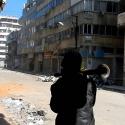 |
 |
Rebel Groups of Jebel Al-Zawiyah

The Assad regime managed to regain control of Damascus after a week of intense fighting, but the regime is unlikely to regain control of the whole country. Nowhere in Syria is this fact more apparent than in Jebal al-Zawiyah, where rebel groups have become so effective and well-resourced that the security forces are unlikely to muster the combat power required to defeat them.
The rebel-held regions in northern Syria are fertile grounds for developing more sophisticated tactics and organizational structure. One of the most important rebel strongholds sits amid the rural hills of Jebel al-Zawiyah between the cities of Hama and Idlib. While the Assad regime focuses its efforts on Syrian cities, border regions, and the coastal provinces, rebel groups in Jebel al-Zawiyah have built command-and-control structures and strengthened their offensive capabilities. Detailed study of the insurgent networks in Jebel al-Zawiyah reveals a shift in tactics that indicates a maturing operational planning capability. IEDs, small-arms fire attacks, and hasty ambushes are giving way to coordinated and sustained attacks against regime targets, particularly since the end of May 2012. In the most recent instance, fighters from a variety of militant groups traveled outside of their traditional areas of operation to conduct a combined raid on a fortified checkpoint on Syria’s main north-south highway, overrunning the checkpoint and cutting off Aleppo from the south. The rebels demonstrated this mobility again when fighters from Damascus’ northern suburbs travelled south to fight the regime in a five-day battle in the heart of the capital. This development is an example of the evolution of rebel capabilities from tactical small unit attacks to the operational attacks of an organized military force.